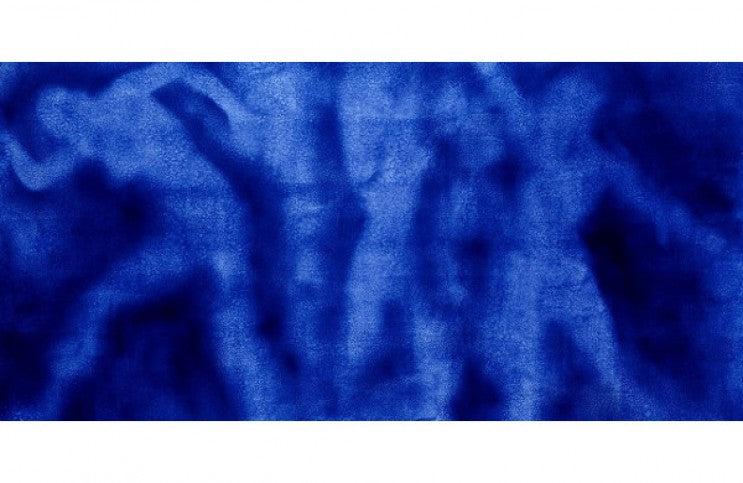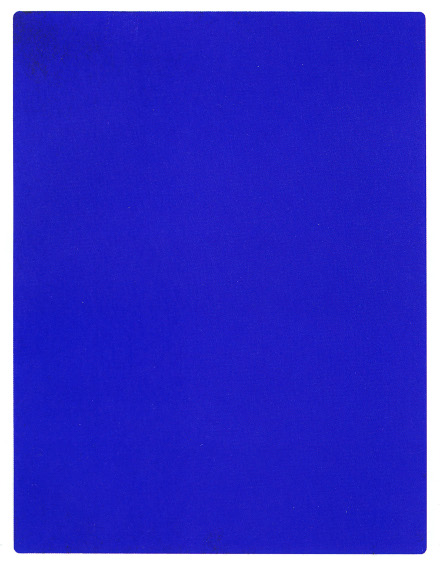
A Word on the International Klein Blue
Had he not died of a heart attack at age 34, Yves Klein would have turned 90 this year. In celebration of this would-be milestone, Blenheim Palace in the UK is currently exhibiting more than 50 Klein works, including multiple pieces made with International Klein Blue (IKB), the eponymous paint Klein developed in 1960. At the time of its creation, IKB was considered by some artists and critics to be an outrage—how, after all, could one artist be so arrogant as to lay personal claim to a color? Others, however, saw Klein as a genius—a predecessor of the time we live in now, when even the most minute and irrelevant intellectual property is jealously guarded. Even today there is much debate on this issue, although that debate is largely fed by a fundamental misunderstanding about what IKB actually is, and what Klein did to lay claim to it. One misunderstanding is the belief that IKB was a new color. It was not. It was a new medium for conveying an existing color. The other misunderstanding was that Klein patented IKB, thereby claiming ownership of it in the eyes of the law. He did not. Klein only registered IKB by way of a Soleau envelope, the official French method of establishing when someone first had the idea for something. The sender of a Soleau envelope makes two copies of a description of an idea. One copy is mailed to the office that registers intellectual property, and the other copy is retained by the registrant. The Soleau envelope that Klein mailed to the French government to register IKB was accidentally destroyed, so it is only by the copy he retained that we can confirm IKB was ever registered at all. Regardless, a Soleau envelope does not imply ownership. It only establishes the time, and the instigator, of an inventive achievement. And the invention of IKB was, indeed, inventive. In fact, its origin story helps explain why Klein was one of the most influential artists of his generation.
What Makes IKB Special
All paint basically starts as a solid. Something like a plant or a rock or a bug is ground to dust and then mixed with a binder, creating something liquid that can be applied to a surface. The color of the solid mostly determines the color of the paint. During Renaissance times, the most precious, rare, and expensive paint color was ultramarine: a spectacular blue pigment. It was created by grinding up lapis lazuli, a type of metamorphic rock, meaning it changes under pressure like coal metamorphosing into a diamond. Though today it is found on at least four continents, back then lapis lazuli was only mined in what is modern day Afghanistan. Its rarity and the cost of import to Europe is what made it so expensive. Its value in turn, along with its particularly vibrant color, gave painters the idea that it was the perfect pigment with which to express royalty and holiness, making it a common color used in religious paintings and portraits of kings and queens.

Yves Klein - IKB 191
Yves Klein also loved the vibrant qualities of ultramarine, but he was disturbed by the fact that when the paint was covered by fixers to preserve the surface of a painting, the fixer would dull the color. He sought a way to create a medium that had the fixer incorporated into it so no additional layers would have to be applied, but also needed a fixer that when added would not diminish the vibrancy of the pigment. Klein hired an expert to assist him with his invention: Edouard Adam, owner of a paint store that is still in operation in Paris today. Adam had the idea to suspend the pigment in a type of wood glue being marketed at the time by a pharmaceutical company. The glue had the rather magical quality of actually making the blue even more vibrant, while also protecting it from fading once applied to a surface. The Soleau envelope Klein registered establishes that IKB is unique because of this process, and that he and Adam developed the process.
Why Klein Needed a Bluer Blue
The reasons Klein had for seeking the most vibrant, pure blue possible were rooted in an early failure he suffered as an artist. Believing that he could use pure color to express the perfect spiritual essence of human feeling, he mounted two consecutive exhibitions in 1955 and 1956 of monochrome canvases, each canvas a single solid, pure color. The paintings were completely misunderstood. The public saw them as decoration rather than as abstract expressions of pure emotion. After some reflection, Klein decided that perhaps the misunderstanding came about because he had made monochromes of multiple different colors, which confused the viewers. He thus decided to focus on one single color for his next exhibition.

Yves Klein - Untitled Blue Monochrome
He selected aquamarine to be that one color partly because of its history as a color connected to spirituality, and partly because for him it represented the color of the sky. When Klein was 19 years old, he famously stood on a beach with his two best friends, the sculptor Arman and the poet Claude Pascal, and divided up the world. Arman took whatever was manufactured, Pascal took whatever was natural, but not alive, and Klein took whatever was natural and alive. Klein then waved his arm as though signing the sky—his ultimate work of art. IKB was an idealized material manifestation of the intention he communicated with that gesture. It was not only the perfect mixture of pigment and resin, but also the perfect mixture of the esoteric and the concrete. Amazingly, he only created around 200 works with IKB before he died. He nonetheless managed in that short time to elevate it to the level of something truly unique, and in the opinion of many people, sacred. Yves Klein at Blenheim Palace, Oxfordshire, England, is on view through 7 October 2018.
Featured image: Yves Klein - Hiroshima
All images via Wikimedia Commons
By Phillip Barcio






